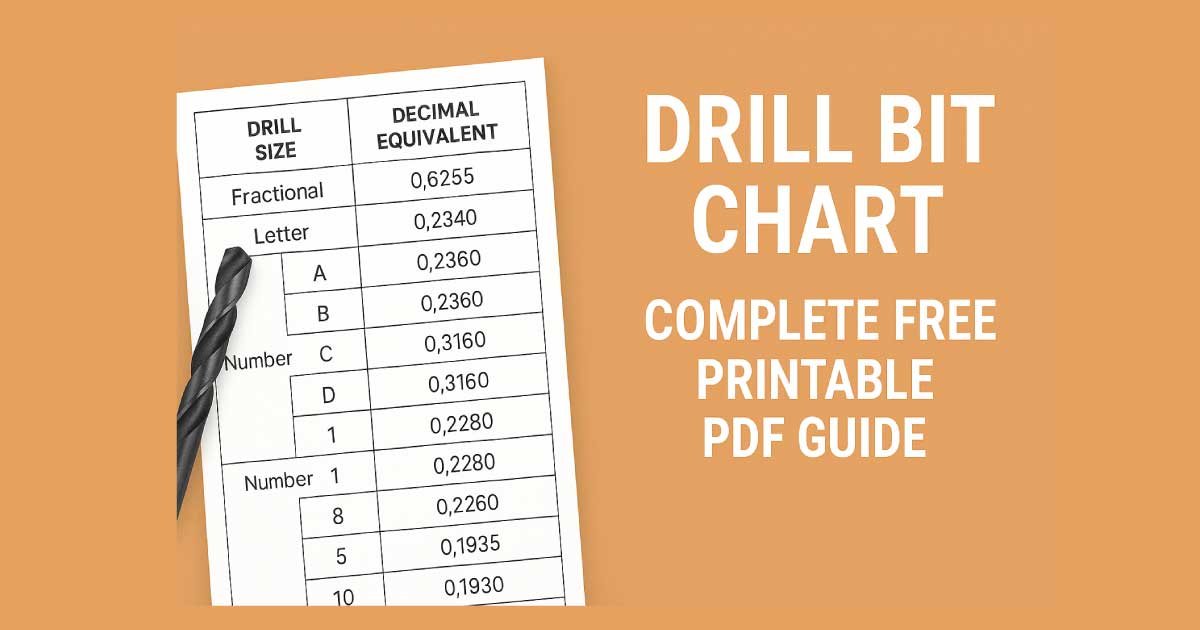A drill bit chart is an essential reference for anyone working with drills, whether in woodworking, metalworking, construction, or DIY projects. Using the right drill bit size ensures precision, avoids damage to materials, and guarantees that screws, bolts, or anchors fit perfectly.
In this guide, we’ll explain drill bit types, sizes, measurement standards, and provide a comprehensive drill bit chart for quick reference.
Why a Drill Bit Chart Matters
Choosing the wrong drill bit can lead to:
Cracked or split wood
Stripped threads in metal or plastics
Misaligned holes that affect assembly
Wasted time and materials
A drill bit chart provides the exact diameter needed for screws, taps, bolts, and anchors, making your work accurate and efficient.
Types of Drill Bits
Drill bits come in various types, each designed for specific materials and purposes:
Twist Drill Bits
Most common type
Used for wood, metal, and plastic
Cylindrical with spiral flutes
Spade Bits
Wide, flat blades
Used for fast drilling in wood
Brad Point Bits
Sharp tip for precise wood drilling
Prevents wandering on the surface
Masonry Bits
Designed for brick, concrete, and stone
Usually have carbide tips
Step Drill Bits
Cone-shaped
Used to drill multiple hole sizes in sheet metal
Forstner Bits
Flat-bottomed holes in wood
Ideal for woodworking projects
Drill Bit Measurement Standards
Drill bits are measured differently depending on the system:
Fractional Inches – Common in the U.S., e.g., 1/4″, 3/8″
Numbered Drill Sizes – #1 to #80, smaller numbers are larger bits
Lettered Drill Sizes – A-Z, often used for small bits
Metric Sizes – Measured in millimeters, e.g., 3mm, 10mm
Each system is often included in a comprehensive drill bit chart.
Drill Bit Chart (Fractional, Number, Letter, Metric)
Here’s a quick reference for common drill bit sizes:
| Fractional Inch | Number | Letter | Metric (mm) | Common Use |
|---|---|---|---|---|
| 1/64″ | 80 | A | 0.41 | Micro drilling |
| 1/32″ | 70 | B | 0.79 | Small electronics |
| 1/16″ | 60 | C | 1.59 | Light wood, plastic |
| 1/8″ | 30 | D | 3.18 | General woodworking |
| 3/16″ | 20 | F | 4.76 | Furniture assembly |
| 1/4″ | 7 | H | 6.35 | Bolts, metalwork |
| 5/16″ | 1 | K | 7.94 | Medium screws, woodworking |
| 3/8″ | – | – | 9.53 | Large screws, construction |
| 1/2″ | – | – | 12.7 | Heavy-duty drilling |
Note: Drill bit sizes may vary slightly depending on manufacturer tolerance.
Drill Bit Chart: Free Printable PDF
Download This Pdf Format Drill Bit Chart
How to Use a Drill Bit Chart
Determine Screw or Bolt Size
Find the diameter of the fastener you plan to use.
Check Material
Softwood → Slightly smaller pilot hole
Hardwood or metal → Follow recommended size exactly
Select the Drill Bit
Match your screw, bolt, or tap to the chart
For pilot holes, use a slightly smaller bit than the screw diameter
Drill Properly
Maintain straight alignment
Use cutting fluid for metal to prevent overheating
Apply consistent pressure for clean holes
Common Applications of Drill Bit Sizes
Small electronics → #60–#80, 1–2mm bits
Woodworking → 1/16″–3/8″ bits for screws, dowels, or anchors
Metal fabrication → 1/16″–1/2″ high-speed steel bits
Concrete or masonry → Carbide-tipped bits, typically 1/4″–3/4″
Also Read:
Tips for Drill Bit Use
Keep Bits Sharp – Dull bits require more force and damage material
Use Pilot Holes – Prevent splitting wood or misaligned screws
Match Drill Speed – High speed for small bits, slower for large or masonry bits
Secure Material – Clamp wood or metal to avoid movement during drilling
Safety Precautions
Wear safety glasses to protect your eyes from debris
Use gloves carefully to avoid entanglement
Secure workpiece with clamps
Keep drill bits in a holder to avoid injuries and damage
Advantages of Using a Drill Bit Chart
Accuracy: Ensures holes are the correct size
Efficiency: Reduces trial and error
Versatility: Works for wood, metal, plastic, and masonry
Universal Reference: Useful for professionals and DIYers alike
Advanced Drill Bit Tips
For Precision – Use a drill press for straight and consistent holes
For Reaming – Slightly oversize the hole and then ream for precision threads
For Multi-Material Projects – Keep separate sets for wood, metal, and masonry
Label Drill Bits – Makes it easier to find the right size quickly
Conclusion
A drill bit chart is an indispensable tool for DIY enthusiasts, woodworkers, metalworkers, and construction professionals. Knowing the correct bit size ensures accurate holes, prevents damage to your materials, and guarantees that screws, bolts, and taps fit perfectly.
Keep a chart handy in your toolbox or workshop. With the right drill bits, proper technique, and careful planning, every drilling project can be precise, efficient, and professional-looking.
Whether you’re drilling tiny electronics holes or large structural projects, a drill bit chart will save you time, reduce mistakes, and improve the quality of your work.
Also Read:

